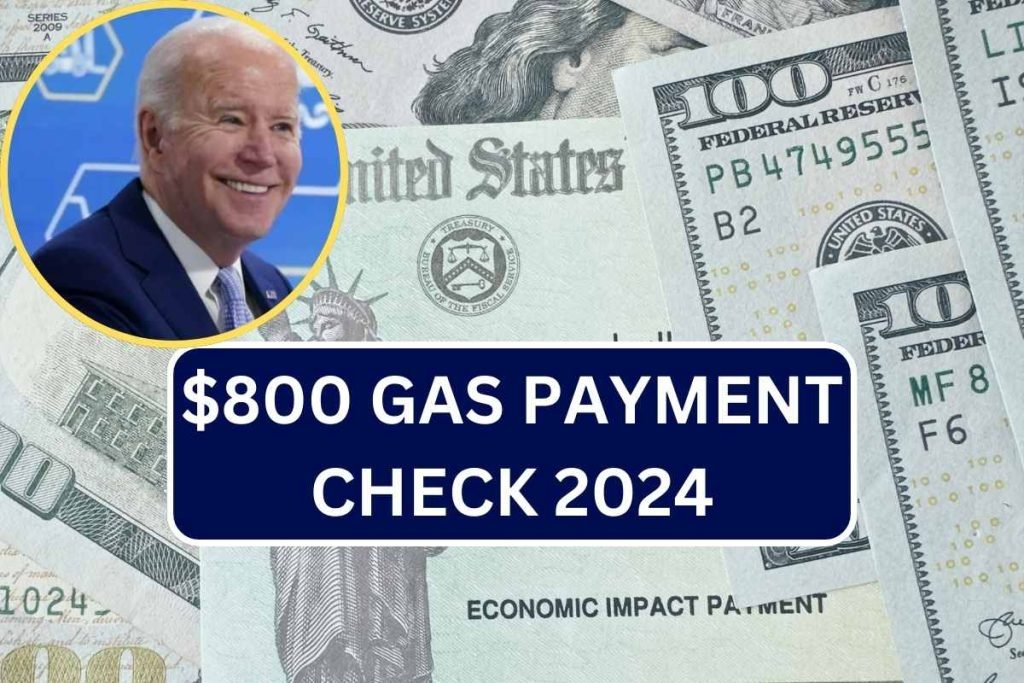The $800 gas payment check has been a topic of significant interest for many Americans, especially with rising fuel prices impacting household budgets. This article will explore the potential for an $800 gas payment check in 2024, examine the facts behind this proposal, and clarify eligibility criteria.

Define the $800 Gas Payment Check
The $800 gas payment check refers to a proposed financial aid that aims to provide $800 to qualifying individuals to help alleviate the burden of rising fuel costs. This measure is designed to support households struggling with increased gasoline prices.
Relevance and Importance
With gas prices fluctuating unpredictably, the potential introduction of an $800 gas payment check would serve as crucial support for many families. Understanding this proposal is essential for budgeting and planning for the future, especially in areas heavily dependent on gasoline.
Types and Categories of Gas Payment Assistance
Federal Gas Payment Programs
1. Direct Payments
Direct payments involve sending cash directly to qualifying individuals. This method is straightforward and allows recipients to use the funds as needed.
2. Gasoline Vouchers
Gasoline vouchers can be redeemed at gas stations, offering a way to directly cover fuel costs.
State-Level Initiatives
1. Emergency Fuel Assistance
Some states may offer emergency fuel assistance in times of crisis, including temporary spikes in gas prices.
2. Subsidized Fuel Programs
Programs that provide reduced rates on gasoline for qualifying individuals or households.
Symptoms and Signs of Rising Gas Prices
Economic Impact on Households
1. Increased Monthly Expenses
Higher fuel prices lead to increased spending on gasoline, affecting overall household budgets.
2. Reduced Disposable Income
With more money spent on gas, less is available for other essential items or savings.
Social Impact
1. Increased Commuting Costs
Higher gas prices can lead to more expensive commutes, affecting workers who travel long distances.
2. Strain on Small Businesses
Businesses that rely on transportation may experience higher operational costs, potentially leading to increased prices for consumers.
Causes and Risk Factors
Factors Driving Up Gas Prices
1. Global Oil Prices
Fluctuations in global oil prices significantly impact local gas prices.
2. Supply Chain Disruptions
Disruptions in the supply chain, such as natural disasters or geopolitical tensions, can affect fuel availability and prices.
Economic Conditions
1. Inflation
General economic inflation can contribute to rising fuel prices as costs across various sectors increase.
2. Currency Fluctuations
Changes in currency value can impact the cost of imported oil, affecting gas prices.
Diagnosis and Tests
Assessing Gas Payment Needs
1. Financial Assessments
Determining eligibility for gas payment assistance often involves a review of financial conditions and income levels.
2. Gas Price Monitoring
Regular monitoring of gas prices can help in assessing the need for financial assistance.
Treatment Options
Government Assistance Programs
1. Fuel Subsidies
Subsidies to reduce the cost of gasoline for eligible individuals.
2. Temporary Aid Programs
Programs that offer temporary relief during periods of high gas prices.
Alternative Solutions
1. Public Transportation
Using public transportation as an alternative to driving can reduce fuel expenses.
2. Carpooling
Carpooling can help lower individual fuel costs by sharing rides with others.
Preventive Measures
Strategies to Mitigate Gas Expenses
1. Efficient Driving Practices
Adopting fuel-efficient driving techniques, such as maintaining proper tire pressure and avoiding rapid acceleration.
2. Regular Vehicle Maintenance
Keeping vehicles well-maintained can improve fuel efficiency and reduce overall gas expenses.
Personal Stories or Case Studies
Real-Life Implications
1. Case Study: Single Parent
A single parent in a rural area faces significant challenges due to high gas prices impacting their ability to commute and manage daily expenses.
2. Case Study: Small Business Owner
A small business owner who relies on transportation for deliveries experiences increased operational costs due to rising fuel prices.
Expert Insights
Advice from Financial Experts
1. Budgeting Tips
Financial experts recommend creating a detailed budget to manage increased fuel costs effectively.
2. Long-Term Financial Planning
Experts suggest considering long-term strategies, such as investing in more fuel-efficient vehicles or alternative energy sources.
Conclusion
Summary of Key Points
The potential introduction of an $800 gas payment check in 2024 aims to provide much-needed relief to those impacted by rising fuel costs. By understanding the types of assistance available, the causes of increasing gas prices, and preventive measures, individuals can better manage their finances and adapt to changing economic conditions.
Call to Action
Stay informed about developments regarding the $800 gas payment check and explore various assistance programs that may offer relief. Planning and budgeting effectively can help mitigate the financial impact of rising fuel costs.
SEO Meta Description
“Explore the potential for an $800 gas payment check in 2024, understand eligibility criteria, and learn how to manage rising fuel costs with our comprehensive guide.”
SEO Optimized Title
“$800 Gas Payment Check 2024: Fact Check, Eligibility, and Relief Options”
Slug
“$800-gas-payment-check-2024”